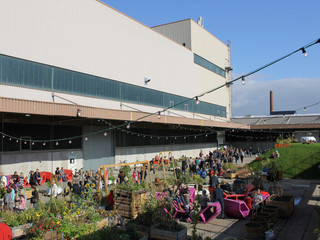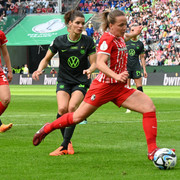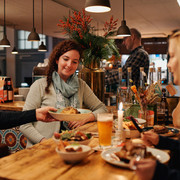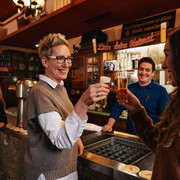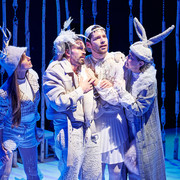Photos & Map
Details
Useful Information
Nearby
Theatre, opera & other stages
Whispers and murmurs, pages rustling, clicking and clacking — the lights go out, silence descends, the stage lights up: the play begins. Stories played out on a stage can be serious and thought-provoking, amusing or completely unexpected — but they’re always clothed in characters and situations that tell us something about people and their characteristic activities. In other words, the theatre offers us an immersive experience that’s in a different category than video consumption and fleeting media tidbits. By contrast, the theatre offers our minds a wealth of multifaceted entertainment that caters to people with many different tastes who appreciate a pleasant evening. The Schauspiel Köln (Cologne theatre) offers you an extensive programme of plays from its artistic repertoire.Outstanding: theatre art in Cologne
In 2011 and 2012, critics honoured the Schauspiel Köln as the best theatre in North Rhine-Westphalia. Our city’s theatre can look back on a long list of prizes and honours. For example, it has been named “Theatre of the Year” by the magazine Theater heute and has also staged a “Production of the Year” — the highest accolade in the world of German-language theatre. These are ideal conditions for your successful theatre evening in Cologne. Here you can take a look at the current programme for the stages of the city of Cologne.The Depot 1 and Depot 2 playhouses — until the original theatres are reopened
Cologne’s theatre — a listed building — and its opera house are being comprehensively renovated and refurbished in a project that was launched in 2012. After using the Expo XXI building as a temporary alternative location until the end of the 2012/2013 season, the Schauspiel theatre in Cologne began to stage its productions in the venues Depot 1 and Depot 2. There is room for an audience of 600 people in Depot 1 — and for about 250 people in Depot 2.The two halls, which can stage their productions in parallel, are located on the grounds of the former Carlswerk company in the Cologne-Mülheim district.
In addition, the new “Kleine Haus” (little house), which is now known as the “Außenspielstätte am Offenbachplatz”, has been used for productions since 2016. Plans call for the stages of the city of Cologne, which include the opera house and other buildings, to reopen for the start of the 2024/2025 season. Until that happens, you can take an interactive look at the construction site (only in German) here.
Dance at Schauspiel Köln: ballet & dance theatre
There’s also dancing on the stages of the city of Cologne — dance ensembles featuring international stars present modern and classical dance events in guest performances at the Depot 1 and Depot 2 playhouses as well as other venues such as the Staatenhaus.The history of theatre in Cologne until 1907: on two stages
Cologne’s first permanent playhouse for theatre performances was established back in 1782 on the street now called the Komödienstraße. A subsequent playhouse was destroyed in a fire in 1869 — and replaced with a new building in the Glockengasse in 1872. In 1902 the city was graced with an attractive new building in the neo-Baroque style with a garden terrace, a restaurant and more than 1,800 seats. Location: Habsburger Ring. Cost: 3.9 million marks. Cologne now had two large stages that were sometimes used in parallel. From the 1906/1907 season on, it had an opera house and a theatre, with plays and operettas performed in the Glockengasse and operas in the new venue.The Nazi regime: theatre during the British occupation
During World War II, both of these buildings were extensively damaged or destroyed altogether. In 1945 theatre performances were once again offered in the auditorium of the university, which became the temporary theatre venue in the British occupation zone. In addition, an expanded hall in the Rautenstrauch-Joest Museum on the Ubierring was used for “chamber theatre” as recently as 1994.Since 1959: theatre venues in Cologne
In 1957 and thereafter, the “multi-genre building” designed by the architect Wilhelm Riphahn on the Offenbachplatz was the combined new venue for opera, ballet, theatre and operettas. In the playhouse that was built directly next to it, the 1962 programme opened with Oscar Fritz Schuh’s staging of Friedrich Schiller’s “Die Räuber”, starring Klausjürgen Wussow.The plans to tear down and rebuild the Schauspiel Köln as part of the expanded renovation of the opera house between 2010 and 2013, were abandoned for financial reasons. Instead, the building is being renovated until its planned reopening.
Useful Information
General Information
Parking Available
Eligibility
Bad Weather Offer
Suitable for any weather
for Groups
for families
for individual guests
Parking facilities
From the railway station Keupstraße, tram line 4, it is about 600 metres to the Schauspielhaus. Take Keupstraße to Schanzenstraße, which will take you directly to the theatre.
Social Media

